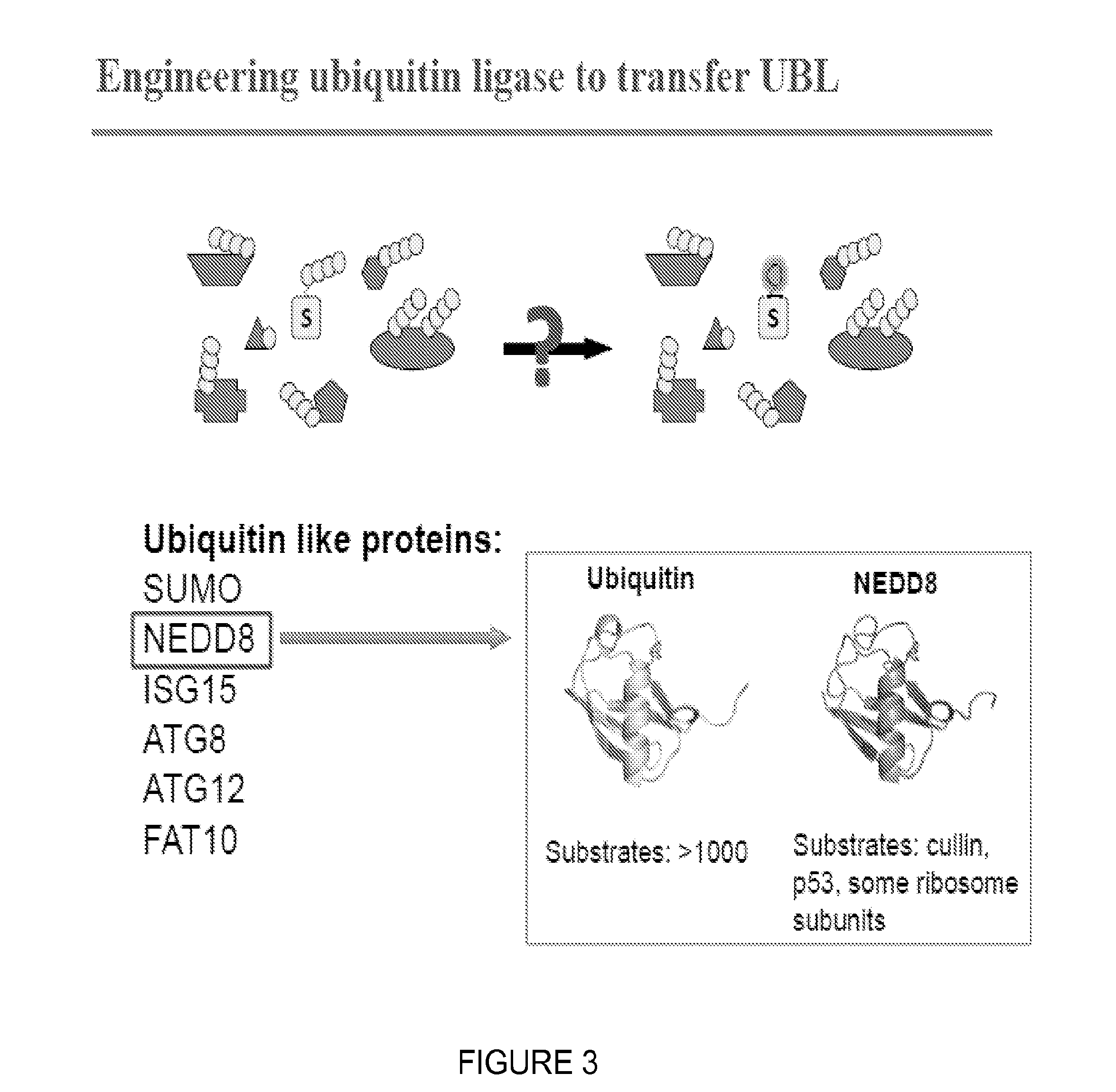Catalytic Tagging System to Study Macro-Molecular Interactions Using Engineered Ubiquitin Ligase and Ubiquitin-Like Proteins to Facilitate Substrate Identification
a technology of ubiquitin-like proteins and catalytic tagging, which is applied in the field of catalytic tagging system to study macromolecular interactions using engineered ubiquitin-like proteins to facilitate substrate identification, can solve the problems of difficult detection of interactions using traditional methods and the challenge of identifying the substrates of a specific e3 hypothesis-driven candidate approach
- Summary
- Abstract
- Description
- Claims
- Application Information
AI Technical Summary
Benefits of technology
Problems solved by technology
Method used
Image
Examples
example 1
Engineering a Catalytic Tagging System for Tagging IAP Substrates
[0118]The RING domains in E3 ubiquitin ligases function to bind ubiquitin E2s and place them in close proximity to the bound substrate so they can catalyze the transfer of ubiquitin from the E2 to amino groups on the substrate bound to its E3 (FIG. 5A). A catalytic tagging system for human XIAP (NEDDylatorXIAP) was engineered by removing the RING domain (residues 435-497) from XIAP to prevent its association with ubiquitin E2 (FIG. 5B). The N-terminus (residues 1-434) of XIAP was then fused via a flexible Gly-Gly-Ser-Gly linker to the NEDD8 E2, Ubc12. This construct was thus designed to ablate the ability to ubiquitinate, but empower the ability to NEDDylate ubiquitin ligase substrates.
Cloning and Recombinant Protein Expression and Purification
[0119]The catalytic tagging systems were generated with overlap extension PCR, including NEDDylatorXIAP, NEDDylatorcIAP1, the FKBP-XIAP fusions and FRB-Ubc12 fusions. These were ...
example 2
Screening for XIAP and cIAP1 Substrates
[0130]To globally identify the substrates of XIAP and cIAP1 using their respective catalytic tagging systems, stable isotope labeling by amino acid in cell culture (SILAC) (Ong and Mann, Nat Protoc 1:2650-2660 (2006))—based mass spectrometry strategy outlined in FIG. 9A was applied.
Stable Isotope Labeling by Amino Acid in Cell Culture
[0131]Jurkat cells were grown in media containing either light or heavy isotopes of lysine and arginine and induced to undergo apoptosis with STS. Light cell extracts were incubated with the respective catalytic tagging system for each of the two IAPs and the heavy extracts labeled only with the wild-type NEDD8 E2, Ubc12. 64 mg regular L-Lys and 83.6 mg L-Arg.HCl were added to 1 liter RPMI-1640 minus L-Lys and L-Arg (Thermo / Pierce), 10% fetal bovine serum (FBS) to generate “Light” medium. 100 mg 13C615N2 L-Lys.2HCl and 86 mg 13C6 L-Arg.HCl (Cambridge Isotope) were added to the same amount of medium to generate the ...
example 3
Identification of a Cleaved Form of PGAM5 with a Neo-IBM Motif Generated by a Non-Caspase Protease
[0139]Among the proteins most strongly labeled by the IAP NEDDylators was PGAM5 (phosphoglycerate mutase family member 5), a recently discovered dimeric protein phosphatase (Takeda et al., PNAS 106:12301-12305 (2009)). PGAM5 is displayed from the outer membrane of the mitochondria through an N-terminal mitochondrial membrane peptide (Lo and Hannink, Exp Cell Res 314:1789-1803 (2008)). It is also believed to play roles in mitochondrial fission and fusion (Imai et al., PLoS Genet. 6:e1001229 (2010)) and in necrotic cell death (FIG. 17) through interaction with the RIP1 / RIP3 kinases (Wang et al., Cell 148:228-43 (2012)).
[0140]There are two transcriptional isoforms of PGAM5, PGAM5L (long form) which is the most abundant and PGAM5S (short form) which lacks ˜80 amino acids at the C terminus (Lo and Hannink, 2008). Most known IAP substrates have two properties: each is processed to an active f...
PUM
| Property | Measurement | Unit |
|---|---|---|
| Composition | aaaaa | aaaaa |
| Interaction | aaaaa | aaaaa |
Abstract
Description
Claims
Application Information
 Login to View More
Login to View More - R&D
- Intellectual Property
- Life Sciences
- Materials
- Tech Scout
- Unparalleled Data Quality
- Higher Quality Content
- 60% Fewer Hallucinations
Browse by: Latest US Patents, China's latest patents, Technical Efficacy Thesaurus, Application Domain, Technology Topic, Popular Technical Reports.
© 2025 PatSnap. All rights reserved.Legal|Privacy policy|Modern Slavery Act Transparency Statement|Sitemap|About US| Contact US: help@patsnap.com



